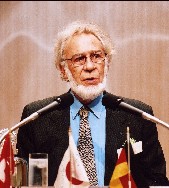��New Generation Month�� Meeting
��Five Years Since Leaving the Frontlines of Teaching��
September 6, 2006
Mr. Frans Hendrickx,
Salesians of Don Bosco, Father,
Ikuei Catholic Center Life Time Education
 ��For 50 years I have learned with students. During those years, a decade between 1985 and 1995, was a transition period when there were periods when children of parents who had experienced war enrolled and periods when children of parents who did not know war enrolled.
��For 50 years I have learned with students. During those years, a decade between 1985 and 1995, was a transition period when there were periods when children of parents who had experienced war enrolled and periods when children of parents who did not know war enrolled.
��I divided the students into three types: V-Type, U-Type, and L-Type.
V-Type students were very serious and had good grades. They had abilities and they had motivation. They were smart and were a type that was able to achieve without much effort.
��U-Type children were those who were those who worked hard diligently. They joined clubs, they would do anything and showed interest in many things and their grades improved.
��L-Type children were those who during the junior high school days spent all of their time playing and to whom teachers never really paid much attention. In high school also, they never laid a root at the school and remained the same. The cause cannot simply be attributed to family or to school. It was clearly an issue that appeared in society.
��The relationship between the student and the parent among the three styles broke down as follows. The percentage of children whose parents were born before or during the war: V-Type 25%, U-Type 40% and L-Type 35% for total of 100%.
��Those whose parents were the post war generation: V-Type 15%, U-Type 65% and L-Type 20% for total of 100%.
��Let us look at the period in which their parents grew up.
��Parents of the pre-war and wartime era had a desire to go to school. They had dreams. They were able to realize their hopes and dreams. On the other hand in the postwar generation, both the parents and children believe that they are the center. They are self-centered and there were very little interactions between the parent and child.
��If one were to describe the difference between the West and Japan using an analogy, Western culture is one of ��wheat�� whereas Japanese culture is one of ��rice��. Wheat, even when it grows and bears fruit, stands upright. Rice, as soon as it ears of rice grows, bows its head. Here, there is a difference in character.
��Western children always have the spirit of independence. They have the spirit to ��grow straight upright�� like wheat. Japanese youth, like the youth in the West have taken on ��straight�� and ��individual��. However, they do not know their own country, their own culture and their own civilization. They do not know their history, and they have no pride. Thus, they find no joy.
Let us describe the children of now using some keywords.
����Image Being��: Children have become Image Beings. Computer screen and self, cell phones, they are all images. Children have become unable to have human-to-human relationships. This is frightening.
��When I was a principal, whenever a student caused a problem, their parent would, without fail, say, ��my child is already grown up �� �� . Each time I heard this, I was disappointed. I created the ��old man club��. While sipping on whisky, they would listen to what each other had to say. Listening to their ��old man��s�� words was a big starting point. From this, fathers began to talk to their children.
����Board Kamaboko Type��: Today��s youth are such type. Kamaboko is a fish paste spread over a board in one lump. Today��s children have no distinguishing character. If one goes left, everyone goes left. They cannot exist on their own.
����Convenience Style��: They long for convenience. They put forth no effort, and they don��t have patience. Whatever they want they get right away. Such children are growing in number. This is a society where children do not need to practice patience. In a world surrounded by convenience, the key will be what kind of role model the parent becomes.
��In the shifting of the generations between those who knew the war to those who do not, many changes are taking place. What is lost is the home atmosphere, and also, the linkage among the past, the present and the future.
��Education is not a place to create things. It is a place to provide opportunities for the future. Thus, I believe that we need to have an interest and hope in education.